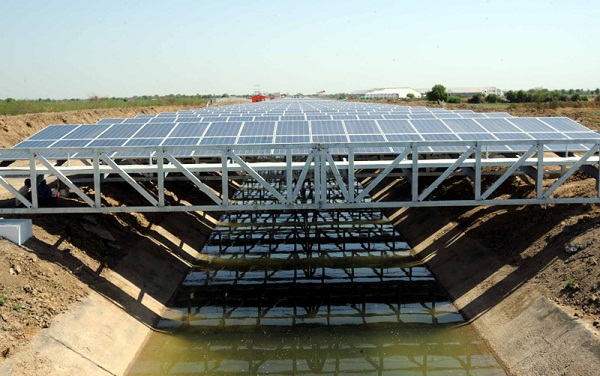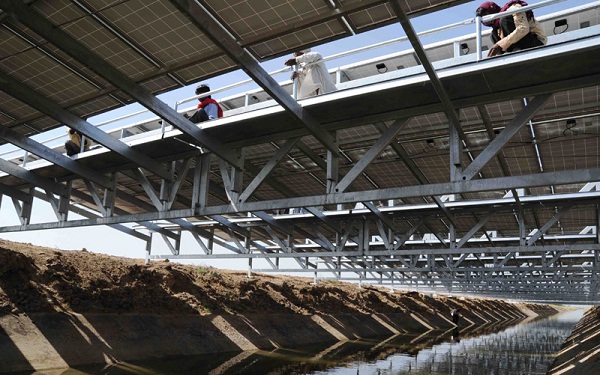Siphoning energy from irrigation canals is getting a little play in the United States; the Seattle-based company Hydrovolts has been testing a turbine in a U.S. Bureau of Reclamaction canal in Washington’s Yakima Valley, and a study by the bureau has suggested that up to 1.5 million megawatt-hours of power could be pulled from manmade waterways every year.
In India, they’re taking a different approach to canals – covering them with solar panels, on racks that span the width of the canals. In April, the state of Gujarat unveiled a project said to generate up to 1 MW of power. Now there are reports that Uttar Pradesh, in the far north of India, bordering Nepal, could be embarking on an even more extensive solar canal project.

The Times of India said the Uttar Pradesh government wants to do canal-based solar in five different areas of the state, and these would be bigger projects than in Gujarat: Each would provide 10 MW, according to Times report.
The paper said a rule of thumb is that it takes 1 to 1.5 kilometers of canal to produce a megawatt of power, so we’re talking anywhere from 10 to 15 kilometers – about 6 to 10 miles – of covered canal in each of the five localities. This in a state that has 74,000 kilometers of canals.

So is this a good strategy?
Surely the racking systems that hold the panels use more materials and thus are more expensive than standard ground-mount systems. But the Indians point to several pluses. There’s the power generated, of course. There’s also the fact that potentially valuable land isn’t eaten up with these arrays. Finally, the Indians say that by covering the canals, valuable water is saved – in Gujarat, they say the installation will prevent the evaporation of “90 lakh litrest of water” annually — 2.37 million gallons, by our calculation.
That claim might run into skepticism at the California State Water Project. In a New York Times piece last year, Todd Woody explored the idea of covering the 400-plus-mile California Aqueduct with floating solar panels. (This isn’t a crazy idea – way back in 2008, the Napa Valley winery Far Niente installed nearly 1,000 panels from SPG Solar over an irrigation pond.)
But a State Water Project rep told Woody that “the reality is that there’s an insignificant loss of water from evaporation on the aqueduct.” Of course, what’s “insignificant” in California, which has a history of profligate water use, might be judged differently in India.
In any case, the water people told Woody that solar-on-the-water wouldn’t produce nearly enough electricity to power the system’s pumping stations, including the Edmonston Pumping Plant that has to get water over a 1,926-foot crest to feed LA’s thirst (see this blog post by Bay Area journalist Dan Brekke on what it takes to move water around California). They seem to think that means it wouldn’t be worthwhile. Nevertheless, according to Austin Troy, author of The Very Hungry City, the state does use hydroelectric generators on the downhill side of the mountain to recover about one-quarter of the energy it takes to bring the water to the top.